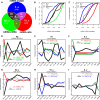Integrative omics analysis reveals the importance and scope of translational repression in microRNA-mediated regulation
- PMID: 23550052
- PMCID: PMC3708174
- DOI: 10.1074/mcp.M112.025783
Integrative omics analysis reveals the importance and scope of translational repression in microRNA-mediated regulation
Abstract
MicroRNAs (miRNAs) are key post-transcriptional regulators that inhibit gene expression by promoting mRNA decay and/or suppressing translation. However, the relative contributions of these two mechanisms to gene repression remain controversial. Early studies favor a translational repression-centric scenario, whereas recent large-scale studies suggest a dominant role of mRNA decay in miRNA regulation. Here we generated proteomics data for nine colorectal cancer cell lines and integrated them with matched miRNA and mRNA expression data to infer and characterize miRNA-mediated regulation. Consistent with previous reports, we found that 8mer site, site positioning within 3'UTR, local AU-rich context, and additional 3' pairing could all help boost miRNA-mediated mRNA decay. However, these sequence features were generally not correlated with increased translational repression, except for local AU-rich context. Thus the contribution of translational repression might be underestimated in recent studies in which the analyses were based primarily on the response of genes with canonical 7-8 mer sites in 3'UTRs. Indeed, we found that translational repression was involved in more than half, and played a major role in one-third of all predicted miRNA-target interactions. It was even the predominant contributor to miR-138 mediated regulation, which was further supported by the observation that differential expression of miR-138 in two genetically matched cell lines corresponded to altered protein but not mRNA abundance of most target genes. In addition, our study also provided interesting insights into colon cancer biology such as the possible contributions of miR-138 and miR-141/miR-200c in inducing specific phenotypes of SW480 and RKO cell lines, respectively.
Figures






Similar articles
-
Predicting the fate of microRNA target genes based on sequence features.J Theor Biol. 2009 Nov 7;261(1):17-22. doi: 10.1016/j.jtbi.2009.07.022. Epub 2009 Jul 28. J Theor Biol. 2009. PMID: 19643113
-
Nucleolin mediates microRNA-directed CSF-1 mRNA deadenylation but increases translation of CSF-1 mRNA.Mol Cell Proteomics. 2013 Jun;12(6):1661-77. doi: 10.1074/mcp.M112.025288. Epub 2013 Mar 7. Mol Cell Proteomics. 2013. PMID: 23471483 Free PMC article.
-
Concordant regulation of translation and mRNA abundance for hundreds of targets of a human microRNA.PLoS Biol. 2009 Nov;7(11):e1000238. doi: 10.1371/journal.pbio.1000238. Epub 2009 Nov 10. PLoS Biol. 2009. PMID: 19901979 Free PMC article.
-
The intricate balance between microRNA-induced mRNA decay and translational repression.FEBS J. 2023 May;290(10):2508-2524. doi: 10.1111/febs.16422. Epub 2022 Mar 11. FEBS J. 2023. PMID: 35247033 Review.
-
Stress-induced reversal of microRNA repression and mRNA P-body localization in human cells.Cold Spring Harb Symp Quant Biol. 2006;71:513-21. doi: 10.1101/sqb.2006.71.038. Cold Spring Harb Symp Quant Biol. 2006. PMID: 17381334 Review.
Cited by
-
High-Throughput Identification of MiR-145 Targets in Human Articular Chondrocytes.Life (Basel). 2020 May 11;10(5):58. doi: 10.3390/life10050058. Life (Basel). 2020. PMID: 32403239 Free PMC article.
-
Tiny giants of gene regulation: experimental strategies for microRNA functional studies.Wiley Interdiscip Rev Dev Biol. 2016 May-Jun;5(3):311-62. doi: 10.1002/wdev.223. Epub 2016 Mar 7. Wiley Interdiscip Rev Dev Biol. 2016. PMID: 26950183 Free PMC article. Review.
-
Integrative analysis of longitudinal metabolomics data from a personal multi-omics profile.Metabolites. 2013 Sep 3;3(3):741-60. doi: 10.3390/metabo3030741. Metabolites. 2013. PMID: 24958148 Free PMC article.
-
Identification and validation of prognostic signature genes of bladder cancer by integrating methylation and transcriptomic analysis.Sci Rep. 2024 Jan 3;14(1):368. doi: 10.1038/s41598-023-50740-x. Sci Rep. 2024. PMID: 38172584 Free PMC article.
-
Integrative Omics Analysis Reveals Post-Transcriptionally Enhanced Protective Host Response in Colorectal Cancers with Microsatellite Instability.J Proteome Res. 2016 Mar 4;15(3):766-76. doi: 10.1021/acs.jproteome.5b00847. Epub 2015 Dec 29. J Proteome Res. 2016. PMID: 26680540 Free PMC article.
References
-
- Bartel D. P. (2004) MicroRNAs: genomics, biogenesis, mechanism, and function. Cell 116, 281–297 - PubMed
-
- Selbach M., Schwanháusser B., Thierfelder N., Fang Z., Khanin R., Rajewsky N. (2008) Widespread changes in protein synthesis induced by microRNAs. Nature 455, 58–63 - PubMed
-
- Farh K. K., Grimson A., Jan C., Lewis B. P., Johnston W. K., Lim L. P., Burge C. B., Bartel D. P. (2005) The widespread impact of mammalian MicroRNAs on mRNA repression and evolution. Science 310, 1817–1821 - PubMed
-
- Filipowicz W., Bhattacharyya S. N., Sonenberg N. (2008) Mechanisms of post-transcriptional regulation by microRNAs: are the answers in sight? Nat. Rev. Genet. 9, 102–114 - PubMed
Publication types
MeSH terms
Substances
Grants and funding
LinkOut - more resources
Full Text Sources
Other Literature Sources
Miscellaneous

